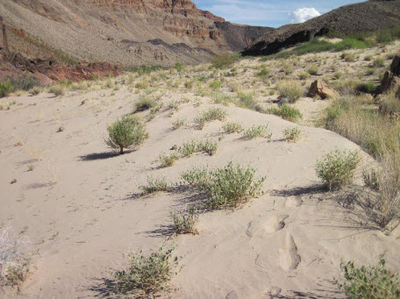Difference between revisions of "Aeolian Sand Transport"
From Glen Canyon Dam AMP
Cellsworth (Talk | contribs) |
Cellsworth (Talk | contribs) |
||
| Line 73: | Line 73: | ||
'''2018''' | '''2018''' | ||
| + | *[https://doi.org/10.1177/0309133318795846 Kasprak et al., 2018, Quantifying and forecasting changes in the areal extent of river valley sediment in response to altered hydrology and land cover: Progress in Physical Geography: Earth and Environment] | ||
*[https://doi.org/10.1016/j.geomorph.2018.07.023 Solazzo, D., Sankey, J.B., Sankey, T.Ts., Munson, S.M., 2018. Mapping and measuring aeolian sand dunes with photogrammetry and LiDAR from unmanned aerial vehicles (UAV) and multispectral satellite imagery on the Paria Plateau, AZ, USA: Geomorphology, v. 319, p. 174-185] | *[https://doi.org/10.1016/j.geomorph.2018.07.023 Solazzo, D., Sankey, J.B., Sankey, T.Ts., Munson, S.M., 2018. Mapping and measuring aeolian sand dunes with photogrammetry and LiDAR from unmanned aerial vehicles (UAV) and multispectral satellite imagery on the Paria Plateau, AZ, USA: Geomorphology, v. 319, p. 174-185] | ||
*[https://doi.org/10.1016/j.aeolia.2018.02.005 Sankey et al., 2018, The response of source-bordering aeolian dunefields to sediment-supply changes 1--Effects of wind variability and river-valley morphodynamics: Aeolian Research] | *[https://doi.org/10.1016/j.aeolia.2018.02.005 Sankey et al., 2018, The response of source-bordering aeolian dunefields to sediment-supply changes 1--Effects of wind variability and river-valley morphodynamics: Aeolian Research] | ||
Revision as of 15:57, 25 September 2018
|
|
Aeolian Sand TransportSand can potentially help preserve archaeological features by direct burial and/or by mitigating gullying and other erosion. Sand can be deposited on archaeological features or within gullies via fluvial (river) or aeolian (wind) deposition. Most archaeological sites are above the highest contemporary river stage, so aeolian deposition is the most likely mechanism for preservation and/or erosion mitigation. River-sourced sand deposition is a time-dependent process, and the outer limit of that process may extend for many years after any individual HFE. Additionally, HFEs with targeted vegetation removal could produce a net sediment surplus at some sites. [1] |
| --- |
--- |
--- |
|---|


